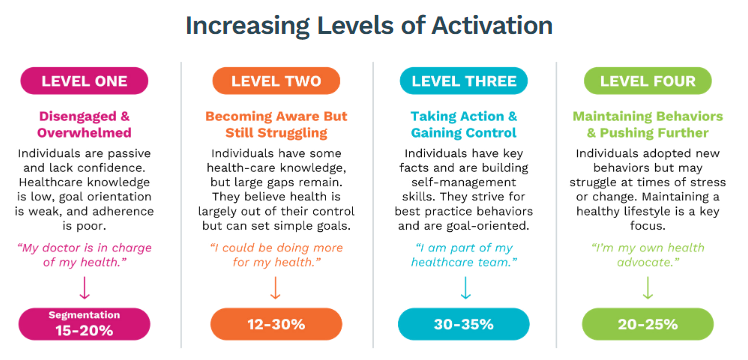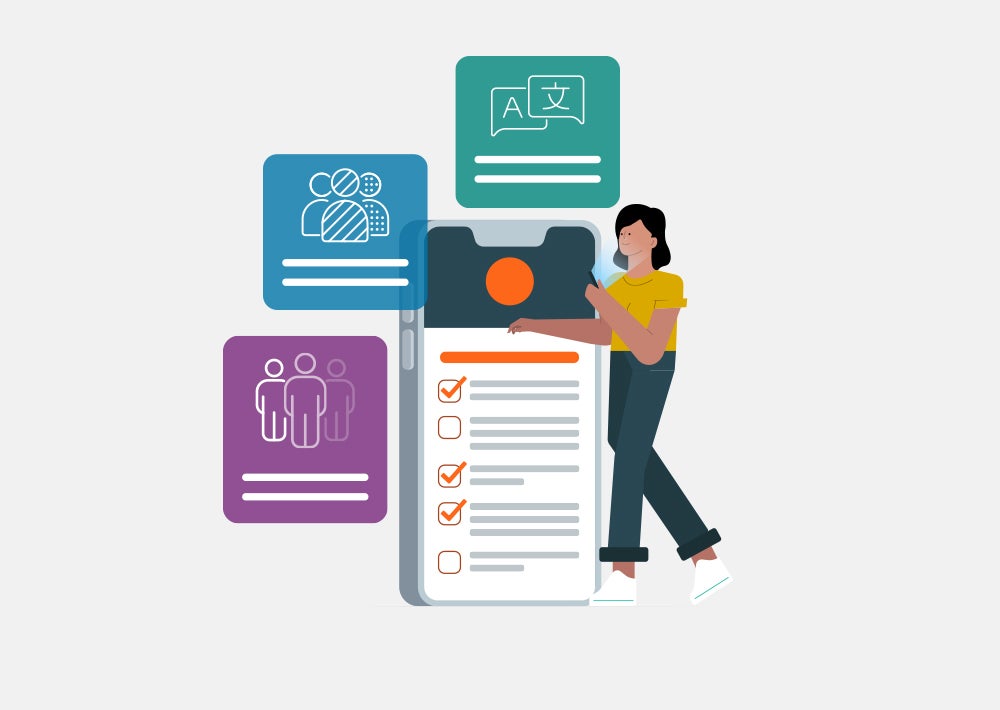What is patient activation?
At its core, the concept of patient activation stems from one underlying question: Does this patient possess the knowledge, skills and confidence to manage their own health and healthcare?
While high-quality medical care is an important determinant of health outcomes, patients’ health behaviors play a large role, too. For patients to sustainably self-manage their health, they must play an active role in it—not be passive recipients of care. That’s the crux of patient activation: Empowering patients to take independent actions to help manage their health and care. Given the immense complexity of our healthcare system, most patients need some level of support to become the best managers of their health—some much more than others.
Why is patient activation important?
Over the past several years, the evidence linking patient activation with better health outcomes, lower costs and better patient experiences has grown considerably. Research shows that activated patients are more likely to engage in information-seeking, preventive and self-management behaviors. And once patients develop the knowledge, skills and confidence to practice those behaviors, they’re inclined to maintain them over the long term.
For many healthcare organizations, focusing on patient activation can seem overwhelming amid mounting pressures to improve clinical outcomes, control costs and adapt to new models of care delivery. Yet all these goals are inextricably linked. Activating patients makes them more engaged in their care, which in turn advances care quality and improves clinical outcomes. Better health outcomes often go hand in hand with lower costs—and both these outcomes can boost healthcare organizations’ performance in value-based care arrangements.
The takeaway? By putting patients at the forefront of their care—and equipping them with the knowledge and skills to self-manage it—providers can better improve the population health of the communities they serve.
Here are 10 strategies to increase patient activation in your healthcare organization:
1. Embrace segmentation
You wouldn’t prescribe the same treatment to every patient. Why should your approach to care delivery be any different?
Segmentation is all about understanding your patients, and there’s a reason why it’s key to patient activation: Patients’ self-management ability exists along a continuum. While activated patients may be well equipped to self-manage their health, disengaged patients may struggle to do so. Less activated patients are easily overwhelmed. Without extensive support, they may not have the confidence or knowledge to adopt new behaviors. If providers use a one-size-fits-all approach, less activated patients can slip through the cracks, making it harder for them to navigate the healthcare system—and less likely to be involved in their treatment or diagnostic choices.
To implement the most effective segmentation approach, start by identifying patients who are most likely to be users of avoidable, costly care. Determine which interventions would be most impactful, then allocate high-touch resources to those patients with high clinical risk and low activation.

According to a 2014 research study, effective segmentation using patient activation provides greater insights into patient risk than one could obtain via demographic or clinical risk factors alone.
“Subdividing and defining a population according to key characteristics can help providers … understand population sub-groups, identify groups who are at particular risk of different health conditions and redefine the way that different patient groups are managed,” the researchers wrote. “This allows them to more closely fit the needs of patients, both clinically and [behaviorally].”
2. Increase patient activation with digital outreach tools
When patient activation is low, the likelihood of readmission—and avoidable emergency department (ED) visits—goes up. Patients with low activation have a harder time managing complex transitions of care, and feeling overwhelmed can make it harder for a person to access care and avert health crises.
In a recent study by JAMA Network Open, researchers found that patients with low activation were more than twice as likely to have unplanned healthcare utilization at 30-day post-discharge than patients with high activation. Those patients also had higher rates of avoidable ED visits, which suggests their clinical needs “could have potentially been managed in a different setting.”
But by using digital outreach tools in the right ways, providers could help patients avoid unnecessary readmissions.
Automated text messages and phone calls can help increase patient activation by reminding patients to self-monitor their health, refill their prescriptions or even schedule preventive care appointments. These tools enable patients to better understand their needs and practice healthy behaviors, making them more likely to seek out health information and understand the treatment guidelines for their condition.
Using outreach to increase patient activation can mitigate gaps in care, too. When patients delay preventive screenings, they’re at higher risk of experiencing negative outcomes—or even developing chronic diseases. As activation increases, patients are more likely to stay up to date with routine ambulatory care. The end result is less time spent in the ED, fewer unexpected costs and better health outcomes overall.
3. Provide self-management coaching
How can providers empower patients to self-manage their care? It all starts with coaching.
The end goal is threefold: Teach patients how to identify and overcome challenges, set goals and address unmet needs throughout their care journey. But like most patient activation strategies, coaching must be based on each patient’s self-management ability. That means providers must tailor their approach based on a given patient’s willingness and ability not only to make effective decisions, but also to take independent actions to maintain or improve their health.
In a disease-management study published by the American Journal of Managed Care, patients who received coaching tailored to their individual level of activation showed greater improvement in their biometrics and in their adherence to recommended regimens—not to mention greater reductions in hospitalizations and in emergency department use.
“Coaches who systematically assess patients’ knowledge, skill, and confidence for self-management can be more targeted and efficient in allocating their time and effort,” the researchers wrote.
To effectively coach patients to self-manage their care, healthcare organizations should consider these tips:
- Meet patients where they are and create actionable steps that give them opportunities to experience success
- Build upon patients’ strengths and successes to help them build confidence
- Identify measurable results to assess patients’ activation and track their progress over time
4. Support patient activation with a team-based approach
Want to improve outcomes for your entire patient population? Get your team on board.
Too often, healthcare fragmentation is a hinderance to patient activation. Care teams can be complex— not only consisting of a patient and a clinician, but also nurses, pharmacists, support groups and dozens of other caregivers. While these stakeholders work toward shared goals, they also have vastly different approaches to patient care. And if care teams don’t communicate effectively, patient outcomes suffer.
“A team-based approach is especially important when caring for patients with complex care needs,” researchers said in a 2018 National Academy of Medicine report. “To manage the large amounts of information and multiple handoffs inherent in caring for complex patients, there is a need for seamless communication and transitions among health care professionals.”
Beyond shared goals and effective communication, care teams need to have measurable outcomes and processes to ensure high-quality performance. By removing barriers between caregivers and patients—and working collaboratively to emphasize each patient’s role in their own care—provider organizations can improve care coordination and continuity. That means higher patient activation, better health outcomes and stronger patient-provider relationships.
5. Administer the Patient Activation Measure® (PAM®)
Without a reliable way to identify patients who need support, providers may struggle to meaningfully engage them in their care—or equip them with the self-management resources they need.
Luckily, there’s a tool for that.
The Patient Activation Measure (PAM) is a brief survey that assesses the underlying knowledge, skills and confidence that are integral to managing one’s own health and healthcare. It segments individuals into one of four activation levels along an empirically derived 100-point scale, and each level provides insight into an extensive array of health-related characteristics—including attitudes, motivators and behaviors.

The PAM is applied is three key ways:
- Improving segmentation and risk identification to identify patients with low activation that traditional risk models often miss
- Tailoring support to PAM level to establish realistic, achievable goals and action steps through an activation-based approach to coaching and education
- Measuring impact to show how patient support strategies and programs can be understood well in advance of traditional outcome measures
More than 750 peer-reviewed journal articles highlight PAM as a key variable. Patient self-management improves significantly as patient activation increases. Additionally, PAM has been included in a National Quality Forum-endorsed performance measure.
6. Personalize your communication
As patients assume more ownership of their health, they need assurance that a healthcare professional is always available to answer questions, evaluate behavioral changes and provide guidance as health concerns arise.
For these patients, one-size-fits-all outreach usually falls short. To increase patient activation, it’s crucial to foster a dialogue.
Patient engagement tools like two-way text messaging, online chats and patient portals can help. These communication channels enable providers and patients to message each other directly—be it to explore a new intervention, discuss an upcoming appointment or speak privately about a health issue. Tailoring messages by PAM level can ensure the language has the best chance of resonating with a given patient’s activation level.
Research backs the value of effective messaging—even for teens. In 2017, a study published in Journal of Pediatrics found that adolescents who received text-message intervention saw significant improvements in their PAM scores when compared to patients who did not receive the intervention.
Digital messaging has become even more important during the pandemic, enabling patients and care teams to have bidirectional goal-setting conversations from anywhere, even during a virtual visit. And for providers looking to deliver more patient-centered care, that’s a key value proposition. When patients can access on-demand health expertise from their mobile device or home computer, they’re more willing to proactively seek it—and less likely to delay important care.
7. Use shared decision-making to increase patient activation
Highly activated patients understand that their doctor is not the sole arbiter of their health. These patients recognize their role as a member of their own care team, and they practice self-management to advocate for their own health.
Shared decision-making—a process by which patients and clinicians work together to make optimal health care decisions—is key. Involving patients in their healthcare decisions helps them learn about their health, keeps them informed about the treatment options available and gives them the information and tools they need to evaluate those options. It also makes patients better prepared to talk with their healthcare provider, more willing to collaborate with their care team and more likely to follow through with a treatment plan that meets their preferences, values and needs.
Put simply, facilitating patients’ shared ownership of their health decisions increases patient activation, which can lead to better health outcomes.
Conversely, failure to embrace shared decision-making can inhibit care quality. Consider this 2018 study from the American Journal of Surgery, where poor shared decision-making was associated with worse patient-reported health outcomes, worse established quality indicators and higher healthcare utilization.
In most healthcare organizations, time is of the essence. Without adjusting clinical workflows, physicians may have limited bandwidth for routine health discussions with patients. If that’s the case for your organization, consider using patient engagement tools, such as templated educational content, to help patients better engage in shared decision-making without over-resourcing clinicians.
8. Focus on social determinants of health
When patients’ social needs are unmet, they tend to have worse health outcomes. They also may lack the motivation, skills and confidence to act.
But as activation increases, patients tend to become more proactive in managing their health and healthcare—regardless of education or income level. Individuals with high activation possess better problem-solving skills, more knowledge about health and more confidence in taking actions to promote and protect it. That’s why it’s crucial for providers to recognize patient activation as a mediating factor between patients’ social determinants of health (SDOH) and their health outcomes.
“Because it is possible to increase patient activation, efforts should focus on both reducing barriers to key determinants of health … as well as implementing efforts to increase patient activation in a population,” researchers said in a 2021 Insignia Health paper. “For example, if a food security program were reaching mostly higher activated patients, it would likely have less of an impact than if the program were able to reach lower activated patients.”
Put simply, higher activation may lessen the impact of SDOH, while lower activation may worsen it. In one study of individuals who lacked health insurance, researchers found that individuals with higher activation were more likely to get needed care without delay and obtain prescribed drugs than were those with lower activation who faced the same circumstances.
“If current efforts aimed at ameliorating SDOH are paired with efforts to increase activation in the population, the effects on health outcomes will be greatly improved over what can be achieved with just a focus on SDOH,” Insignia Health researchers said.
9. Limit no-shows and reduce gaps in care
No-shows aren’t just bad for providers. Patients who repeatedly miss or cancel appointments have increased rates of ED visits, more hospitalizations and poorer chronic disease-management—all symptoms of low patient activation.
Patient engagement is the key to reducing no-shows. Sending automated appointment reminders, for example, gives patients multiple opportunities to confirm or cancel their visit, which can prevent no-shows and last-minute cancellations. In fact, one study found that when parents of pediatric patients received a text message in addition to a phone call reminder, no-shows dropped by more than 14%. Other patient engagement tools, like self-scheduling, can reduce no-shows by making patients more active in their care, which in turn increases patient activation.
Healthcare organizations contracted under value-based care agreements should focus on resolving gaps in care since a portion of their revenue is typically based on their ability to keep patients with chronic illnesses as healthy as possible. To do so, organizations should focus on consistent, targeted patient engagement. Messaging that emphasizes the importance of staying up to date with routine ambulatory care increases patient activation, keeps patients out of the hospital and helps them avoid unexpected costs.
10. Engage patients after their visit
At this point, you probably recognize the relationship between engagement and patient activation. Engaging patients in their care increases their activation and can help improve their health outcomes. What better way to maximize engagement than by communicating with patients after their visit?
Patient surveys enable providers to gauge patients’ thoughts, feelings and perceptions about their care after the clinical encounter ends. These insights are foundational to the patient-provider relationship, giving providers individualized context to help them fine-tune the patient experience. And since patient satisfaction is linked to patient activation, it’s crucial that providers not only ask patients about their care experience, but also use that feedback to guide operational changes.

In fact, patient surveys are a key confidence-building intervention activity, according to a guide by Ipsos MORI and The Strategy Unit. When patients can confidently reflect on their healthcare experience, they’re inherently more engaged in their care—and their patient activation level is likely to improve.
Learn how Phreesia can help you increase patient activation, improve health outcomes and engage patients in their care.




